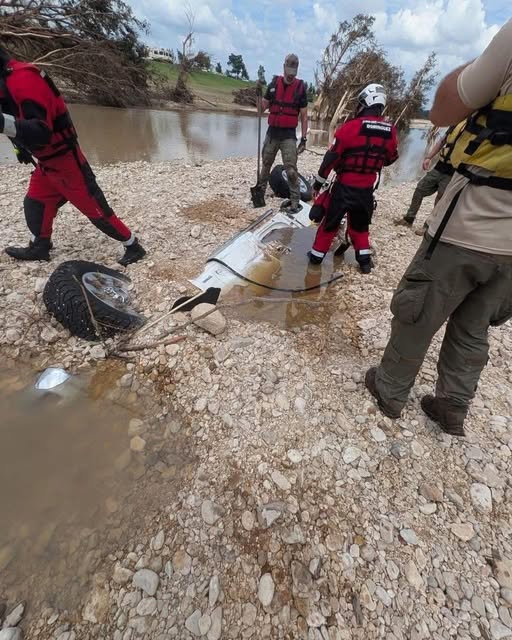In the aftermath of the catastrophic flooding that swept across parts of Texas, the grim task of search and recovery has taken on new urgency and complexity. First responders and recovery crews are now working in treacherous terrain, made even more challenging by receding floodwaters that slowly reveal the scale of devastation hidden beneath the surface. In many cases, the victims—like so much else left behind—are being found in the most heartbreaking of ways: a glimpse of cloth trapped under debris, a hand reaching from a collapsed car, fingers barely visible beneath thick layers of mud.
The scope and intensity of these recovery efforts have grown clearer with each passing day, as officials confirm that vehicles, homes, and entire structures remain submerged or partially buried. Search crews, many drawn from across the state and beyond, have stated that specific areas must be examined multiple times due to the unpredictability of the water levels. One area can appear empty one day and then—just a few inches of receding water later—reveal a body or vehicle once thought lost forever. This haunting cycle is a reminder not only of nature’s ferocity but also of the human toll exacted in just minutes of destruction.
The situation has grown especially dire in the Texas Hill Country, particularly along the Guadalupe River corridor where floodwaters surged with such intensity that entire communities were uprooted. In these regions, officials say the recovery mission has shifted from swift-water rescue to painstaking forensic detection. A member of one of the state’s disaster recovery teams noted that many victims have been discovered in vehicles that were swept away and crushed against rock formations or trapped under fallen trees, invisible to helicopters and drones until the waters pulled back.
Even for veteran responders, the process is emotionally taxing. “We’re not finding people by sight,” one responder stated. “We’re finding them by instinct, by shadows under the water, by a sleeve poking out from the dirt, or a shoe lodged between branches.” It is, they say, a job that demands patience, precision, and an unwavering commitment to bringing families closure, no matter how difficult the circumstances.
While the official death toll continues to rise, the stories behind each victim carry weight far beyond numbers. Families have spent sleepless nights waiting for news, clinging to hope as long as possible, even when hope wanes. The timeline of the flooding is clear enough—sudden storms, overflowing rivers, warnings that sometimes came too late—but the emotional timeline is murkier. For the loved ones of the missing, every hour drags with dread.
This particular flood event is one of the worst Texas has seen in decades, drawing comparisons to other deadly disasters such as Hurricane Harvey in 2017. Yet in some ways, this flood has proved more insidious. Unlike a hurricane, which carries days of warning, the flash floods in Hill Country surged with shocking speed, overwhelming communities in minutes. Camps, RV parks, and riverside homes were swallowed whole. Rescue crews recall being called to one site in the middle of the night, only to find that buildings had vanished by morning. Children asleep in bunks were swept away. Cars were carried for miles and now rest twisted around trees or sunk beneath collapsed bridges.
The challenges extend beyond physical recovery. Officials are now grappling with the psychological impact on both the rescuers and the families affected. Many search and rescue workers are being rotated out to receive mental health support, while counselors are embedded within the recovery operations to provide on-the-ground intervention. “We’re trained for disaster response, but nothing prepares you for pulling a child from a car days after the water has gone down,” said one first responder.
What has also emerged is a broader conversation about infrastructure resilience and floodplain management in Texas. Critics argue that unchecked development in vulnerable river basins and the failure to reinforce levees or maintain drainage systems contributed to the scale of the disaster. For years, local emergency managers have warned of the Guadalupe River’s volatility, especially during concentrated rain events. Those warnings have now become chillingly real.
Meanwhile, recovery teams continue their methodical work, often returning to the same sites three or four times in hopes of recovering what was once hidden. Sonar systems and cadaver dogs are being used extensively. Still, many discoveries come not from technology, but from gut instincts and careful re-examination. One recovery diver described locating a vehicle wedged between boulders only because he saw what appeared to be a ripple in the wrong direction. Inside, a victim was found, face down, obscured by the gloom and sediment.
The implications of the flood stretch beyond individual tragedies. Economic recovery in the region will take years. Entire livelihoods—especially those built around tourism, agriculture, or seasonal camp operations—have been obliterated. Some towns are still without power. FEMA and the state of Texas have pledged millions in assistance, but local officials caution that no dollar amount can undo the trauma that now defines their communities.
Perhaps the most harrowing legacy of the flood is its invisibility. For days, helicopters flew over deceptively calm water, unaware of the carnage below. It wasn’t until the water began its slow retreat that the horror became fully visible. The river, it turns out, kept its secrets until it couldn’t anymore.
As responders continue combing the region for signs of the missing, the story of this disaster continues to unfold—not just in official reports, but in the faces of those who search, those who grieve, and those who wait.

